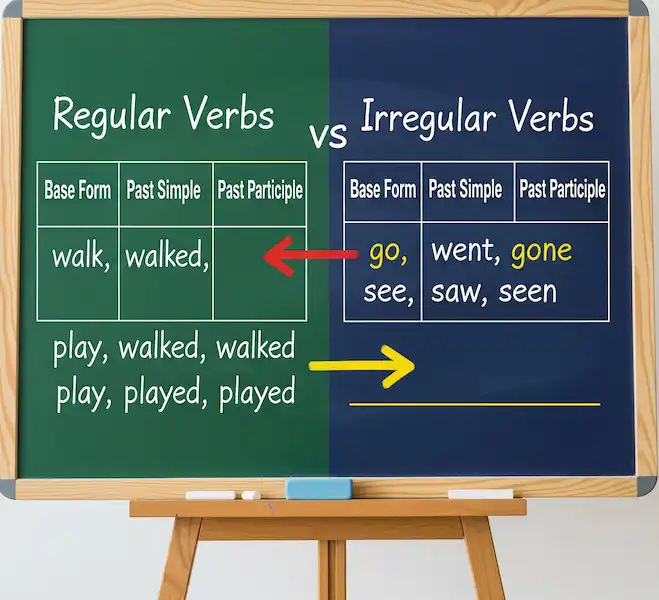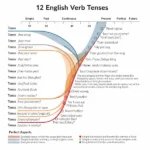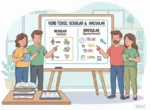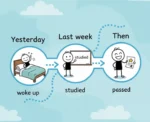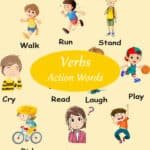Regular vs Irregular Verbs: Cracking the Code! 💪
Welcome, beginner English learners! This article will help you understand the difference between regular and irregular verbs. Don’t worry, it’s not as scary as it sounds! We’ll break down the rules with lots of examples and helpful charts. Let’s get started! Learn to speak and write English better knowing how to use regular vs irregular verbs
What are Verbs?
First, let’s remember what a verb is. A verb is a word that describes an action (like run, eat, sleep) or a state of being (like be, seem, feel). Every sentence needs a verb!
Regular Verbs: Easy to Follow Rules! 👍
Regular verbs are like rule-followers! They change their form in the past simple and past participle by usually adding -ed. Here’s a simple rule:
- Present: walk
- Past Simple: walked (+ -ed)
- Past Participle: walked (+ -ed)
Past Simple is used to talk about actions that happened in the past. Past Participle is often used with auxiliary verbs like have (e.g., I have walked) or be in passive sentences (e.g., The dog was walked).
Regular vs Irregular Verbs – Here are some more examples:
| Present | Past Simple | Past Participle |
| play | played | played |
| listen | listened | listened |
| watch | watched | watched |
| clean | cleaned | cleaned |
| smile | smiled | smiled |
Special Cases for Regular Verbs:
- Verbs ending in -e: Just add -d.
- like -> liked
- dance -> danced
- Verbs ending in a consonant + vowel + consonant (except -w or -x) with stress on the last syllable: Double the last consonant and add -ed.
- stop -> stopped
- plan -> planned
- Verbs ending in -y after a consonant: Change the -y to -i and add -ed.
- study -> studied
- cry -> cried
Irregular Verbs: The Rule Breakers! 🙅♀️
Irregular verbs are a bit trickier because they don’t follow the -ed rule. Their past simple and past participle forms can change in many different ways. Unfortunately, the best way to learn them is by memorizing them through practice and repetition.
Regular vs Irregular Verbs – Here’s a list of some common irregular verbs you need to know:
| Present | Past Simple | Past Participle |
| be | was/were | been |
| have | had | had |
| do | did | done |
| eat | ate | eaten |
| drink | drank | drunk |
| go | went | gone |
| come | came | come |
| see | saw | seen |
| take | took | taken |
| give | gave | given |
| make | made | made |
| get | got | got/gotten |
| know | knew | known |
| speak | spoke | spoken |
| write | wrote | written |
| find | found | found |
| think | thought | thought |
| say | said | said |
| tell | told | told |
| put | put | put |
| read | read (/red/) | read (/red/) |
Important Note: Notice that some irregular verbs have the same form in the past simple and past participle (e.g., put, cut), while others have completely different forms for all three tenses (e.g., go, went, gone).
Practice Makes Perfect! ✍️
The key to mastering regular and irregular verbs is practice! Try these exercises:
- Fill in the blanks:
- Yesterday, I ______ (play) football with my friends.
- She has ______ (eat) all the cookies!
- They ______ (go) to the market this morning.
- He ______ (watch) a movie last night.
- We have ______ (see) that film before.
- Identify the verb tense: Are the verbs in these sentences in the present, past simple, or past participle form? Are they regular or irregular?
- She speaks English very well.
- We cleaned the house yesterday.
- Have you ever traveled to another country?
- They made a delicious cake.
- I am listening to music.
Connecting with Your Life
Learning verbs is super useful for your daily life! Here are some examples of how you can use them:
- Talking about your day: “This morning, I walked to school and then I ate rice for lunch.”
- Asking questions: “Have you seen the new temple?” “Did you go to Phnom Penh last week?”
- Sharing experiences: “I learned some Khmer words yesterday.” “We visited Angkor Wat last month.”
Knowing these verbs will help you communicate more effectively with your friends, teachers, and everyone around you!
Here is a PDF worksheet you can download to practice Regular vs Irregular Verbs, 25 practice sentences. The answers are on a separate page.
Additional Helpful Content: Tips for Memorization 🧠
- Use flashcards: Write the present form on one side and the past simple and past participle on the other. Test yourself regularly!
- Practice with sentences: Create your own sentences using different irregular verbs in different tenses.
- Listen and read: Pay attention to the verbs used in English songs, movies, and books.
- Use online resources: There are many websites and apps that offer exercises and quizzes on regular and irregular verbs.
Additional Helpful Information
- Study more about modal verbs – English Modal Verbs: ‘May,’ ‘Might,’ ‘Could’: English Possibility
- Study more about past tense – Past Continuous vs Simple Past: A Simple Guide
- learn more about using passive voice – Passive Voice: When & How to Use It Correctly
External Links for More Learning 🔗
- British Council – Irregular Verbs: https://learnenglish.britishcouncil.org/grammar/english-grammar-reference/irregular-verbs
- Cambridge Dictionary – Grammar: https://dictionary.cambridge.org/grammar/english/
Keep practicing, and you’ll become a verb master in no time! Good luck with your English studies! 😊
